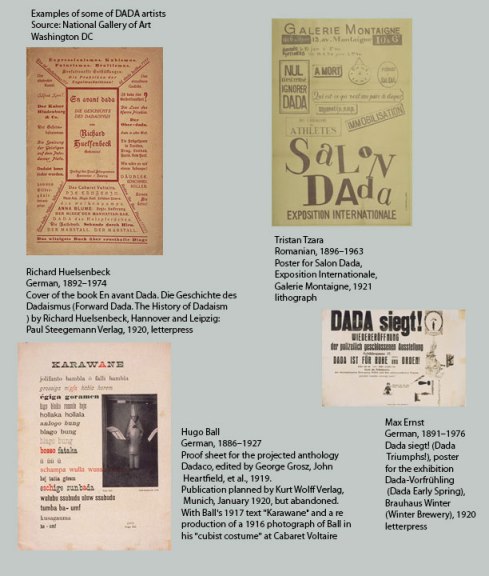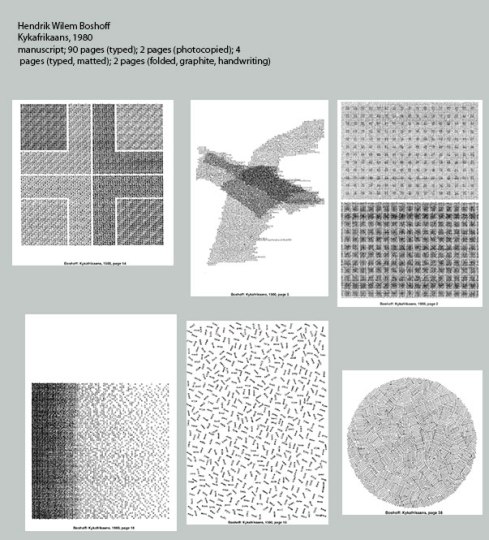Parallel to the development of automobiles, airplanes, and Einstein ideas changing the perception of the Universe, artists were also part of this era of innovation and creative energy known as Modernism, grouping themselves under different banners: Cubism, Futurism, Expressionism, Surrealism, among others, questioning and re-inventing their art.
From all these movements, the Futurist philosophy challenged the conventions that dominated typography at the time: clarity, simplicity and readability. Paraphrasing E.E. Cummings, the futurist used typography as a medium of meaning. Their goal was that people looked at the surface instead of “looking through words.” (4)
One part I found particularly interesting of Futurism was the collaborations between visual and literature artists, especially the visual poems or the turn of visual artist into poets or vice-versa.
Before Futurism there were works on visual graphics with fonts or words, like the ones presented in Megg’s History of Graphic Design by Lewis Carroll, and Stèphane Mallarme. Later, during the years of the First World War and the end of the war, Marinetti, the founder of Futurism and other poets like Apollinaire began publishing more visual poems.
Bellow examples of Apollinaire most celebrated calligrams.

History continues and the First World War left an estimated of 16 million deaths and about 20 million people wounded; the deadliest conflict in human history. Adding to this catastrophe, the Russian Revolution had it’s share of deaths and later Europe lived on their soil the horrendous Second World War. These forty something years of the twenty century were for artists a time of deep disillusion with the values of the whole civilization. Thus, the pre-war Avant-Garde movement influenced the birth of Dadaism. With an opposite angle towards war and strong anti-bourgeois conventions when compared with the Futurist, Dadaist also had strong visual poets and book’s artists and literature.
It seems to me that both Futurism and Dadaism inspired artists in 1950, when the interest in typography came back in the form of what is known as Concrete Poetry, visual poems, of visual art made with words. They are meant to be seeing on a surface rather and read. When read, they lose part or all the effect.
The term Concrete Poetry was originated by Max Bill and Öyving Fahlström in Europe early 1950 and then it was used by the first exhibition of concrete poetry in 1956 in Sāo Paulo, Brazil. The movement spread throughout all the continents rapidly, became less abstract and some artists called “Visual Poetry” to describe a movement that fusions photography, film, illustration with letters and words to achieve new effects.
Bellow examples of the Brazilian Augusto de Campos (1931, Sāo Paulo, Brazil) this poet, together with his brother Haroldo founded Concrete Poetry in Brazil, during a time of political turmoil in their country. Since 1980, de Campo moved from printed poems to experiments with billboards, video-text, neon, holograms, laser, computer graphics and multimedia events in collaboration with other visual artist and musicians.
The following is example of de Campos collaboration with one of my favorites Brazilian composers, Caetano Veloso in which Veloso made the music for the poem “Pulsar”
http://www.youtube.com/watch?v=BfO6r1t0E9Q
In a way, the cycles of art, are re-taken with new technologies, new sensibilities, crossing oceans back and forth. Perhaps the artistic movements have now different names in different countries and it seems to me that more or less, the same happened during the era of Modernism. There are all like tied with ‘fishing lines” that become visible when comparing Modernist artist with artist working these days in Concrete poems or Visual Poetry. I also find intriguing the way some of the artist of our generation use this genre to address the economic and socio-political problems we are living worldwide.
These last three images present current artist working on visual poetry.
Jeremy Alder, England
Hendrik Wilen Boshoff , South Africa
and Rachid Koraichi from Argelia-France
Koraichi is talking at Stanford University on Thursday January 24, 2013, 5:30 pm at the Cantors. The Cantors Art Center would have his work from December 12, 2012 through March 10, 2014

Prints done by Koraichi based upon fragments of a poem by the Palestinian activist poet, Mahmoud Darwish. Koraichi wrote the poems and drew signs, symbols and ideograms onto zinc plates that were then printed with black ink except for small sectors of the prints with red ink.
References
1. Archetype Press http://www.artcenter.edu/accd/campus/archetype_press.jsp
2. Arts Bri.com http://www.arslibri.com/catalogues/cat137n.pdf
3. Cinco Poemas Conretos (Five Concrete Poems) from Brazil
http://movingpoems.com/poet/augusto-de-campos/
4. Cummings, E.E. Looking At and Looking Through: Futurism, Dada, and Concrete ,Poetry.org https://www.poets.org/viewmedia.php/prmMID/593
5. Concrete-Poetry-as-an-International-Movement-Viewed-by-Augusto-de-Campos http://www.scribd.com/doc/36967268/
6. Honing, Edwin, A Brief Guide to Concrete Poetry, Poetry.org https://www.poets.org/viewmedia.php/prmMID/5649
7. Meggs, P.B., Purvis, A.W. Megg’s History of Graphic Design,Wiley& Sons, fifth ed., 2012
8. National Gallery of Art, Washington DC. http://www.nga.gov/home.htm
9. Poetry, a brief guide to Futurism https://www.poets.org/viewmedia.php/prmMID/5656
10. The Sackner Archive of Visual and Concrete Poetry
http://ww2.rediscov.com/sacknerarchives/Welcome.aspx
11. Wikipedia http://en.wikipedia.org/wiki/World_War_I_casualties





Leave a comment